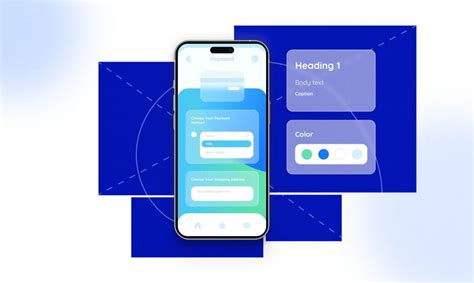Discover the art behind creating captivating and seamless journeys for your online visitors. In this insightful article, we delve into the realm of website optimization, helping you master the art of crafting extraordinary user encounters. By implementing these effective strategies, you can transform your web presence into an immersive digital realm that keeps your audience coming back for more.
Unleash the power of user experience with our range of expert techniques. Employing intelligent design choices and intuitive navigation, your website can effortlessly guide users through a delightful online venture. Engage your visitors by tailoring their experience to their unique needs, leaving them wanting to explore further and discover all that your website has to offer.
Embark on a journey of discovery as we explore the secrets to creating meaningful connections with your audience. With the use of attention-grabbing visuals, compelling content, and a seamless interface, you can establish a strong emotional bond that captivates and retains your users. Foster an environment of trust and loyalty, and watch as your online presence thrives like never before.
Understanding Your Target Audience

Getting to know your intended audience is a crucial aspect of creating a successful website. By gaining a deep understanding of the individuals you are targeting, you can tailor your content, design, and features to meet their specific needs and preferences.
- Identify the demographics of your target audience: age, gender, location, etc.
- Analyze their interests, hobbies, and lifestyle choices.
- Consider their educational background and profession.
- Explore their motivations, goals, and pain points.
- Examine their online behavior and browsing habits.
By comprehending these aspects, you can create a website that truly connects with your target audience. This understanding will guide your decisions regarding the layout, color schemes, typography, and overall user experience.
- Develop user personas that represent different segments of your target audience.
- Conduct surveys, interviews, or focus groups to gather valuable insights.
- Utilize analytics tools to track user behavior and identify patterns.
- Regularly update and refine your understanding of your audience as their preferences evolve.
Keep in mind that your website should be designed to engage and delight your target audience. By consistently catering to their preferences and providing relevant content, you can ensure a positive user experience that keeps them coming back for more.
Simplifying Navigation and Information Architecture
Improving the ease of navigating through a website and organizing its information architecture is crucial for enhancing user experience. By streamlining the way users find and interact with content, businesses can create a more intuitive and enjoyable browsing experience.
The first step in simplifying navigation is to categorize and prioritize website content. By organizing information into logical groups and arranging them based on their importance, users can easily locate the content they need. This can be achieved through the use of clear and concise labels, menu structures, and navigation paths.
Another effective way to improve navigation is by implementing a search functionality. By providing a search bar prominently on the website, users can directly search for specific content, saving time and effort. It is essential to optimize the search function to ensure accurate and relevant results are displayed to the users.
- Use descriptive and concise page titles and headings to provide users with a clear understanding of the content.
- Minimize the number of clicks required to reach desired information by reducing the depth of the navigation menu.
- Utilize drop-down menus or mega menus for websites with a large amount of content to avoid overwhelming the users.
- Include breadcrumbs at the top of the page to give users a sense of their location within the website.
- Implement intuitive icons and symbols to aid in quickly identifying different sections or actions on the website.
- Ensure that the website is mobile-friendly and responsive, as more users access websites from their smartphones and tablets.
By simplifying the navigation and information architecture of a website, businesses can create a user-friendly environment that allows visitors to easily access the desired information and navigate through the website effortlessly. This ultimately leads to higher engagement, increased conversions, and a positive overall user experience.
Improving Website Speed and Enhancing Performance

In this section, we will explore effective strategies to optimize the speed and performance of your website. By implementing these techniques, you can ensure a seamless browsing experience for your users while maintaining high levels of performance of your website.
- Optimize image sizes: By reducing the file sizes of your images without compromising the quality, you can significantly enhance the loading time of your website.
- Minify CSS and JavaScript: Minifying these files by removing unnecessary characters and spaces can reduce their file size, resulting in quicker load times for your web pages.
- Enable browser caching: By enabling browser caching, you can store certain elements of your website in a user's browser, allowing for faster loading times upon subsequent visits.
- Utilize content delivery networks (CDNs): CDNs can help distribute your website's content across multiple servers worldwide, reducing latency and improving load times for users located in different geographic regions.
- Implement lazy loading: By using lazy loading techniques, you can delay the loading of certain non-critical elements on your web page until they are actually needed, thus reducing the initial load time.
- Minimize HTTP requests: Reduce the number of HTTP requests required to load your website by combining multiple files, such as CSS and JavaScript, into a single file.
- Optimize server response time: Ensure your server is properly configured and optimized to minimize the time it takes to respond to user requests, resulting in faster overall page load times.
- Use a content delivery network (CDN): By utilizing a CDN, which stores copies of your website on servers located closer to your users, you can decrease latency and improve load times.
- Regularly update and optimize plugins and scripts: Keep your website up to date with the latest versions of plugins and scripts, as they often include performance optimizations and bug fixes.
- Monitor and analyze website performance: Utilize tools to regularly monitor and analyze the performance of your website, identifying any areas for improvement and implementing necessary optimizations.
By following these strategies, you can ensure that your website operates efficiently and delivers a fast and seamless experience for your users.
Optimizing Your Website for Mobile Devices with Responsive Design
Creating a Seamless Mobile Browsing Experience
As technology advances and more people access the internet through mobile devices, it is crucial to ensure that your website is compatible and responsive across various screen sizes. By implementing responsive design, you can optimize your website for mobile devices, providing a seamless browsing experience for your users.
Adapting Your Design to Different Screen Sizes
Responsive design involves designing and developing your website in a way that allows it to adapt and respond to different screen sizes and orientations. This means that regardless of whether a user is browsing on a smartphone, tablet, or desktop computer, your website will adjust its layout and content to provide the best possible user experience.
Improving Usability and Accessibility
Implementing responsive design not only enhances the visual appeal of your website on different devices but also improves its usability and accessibility. A responsive website ensures that your content is easily readable, navigable, and interactive, regardless of the device being used. This enhances user satisfaction and encourages them to spend more time on your site.
Boosting Search Engine Visibility
In addition to providing a better user experience, responsive design can contribute to your website's search engine visibility. Search engines, like Google, prioritize mobile-friendly websites when displaying search results on mobile devices. By making your website responsive, you increase the likelihood of it ranking higher in search engine results, driving more organic traffic to your site.
Staying Ahead of the Competition
With the increasing use of mobile devices for internet browsing, implementing responsive design is no longer an option but a necessity. By optimizing your website for mobile compatibility, you can stay ahead of your competition, attract more visitors, and ensure that your brand is accessible to users across different devices.
Improving the Visual Appeal and User Interface

In today's digital landscape where websites play a crucial role in engaging and retaining users, enhancing the aesthetics and usability of your website is paramount. By focusing on visual design and user interface, you can create a captivating online experience that keeps visitors coming back for more.
One key aspect of enhancing visual design is paying attention to the overall layout and organization of your website. A well-structured and intuitive interface allows users to easily navigate through your content, find what they are looking for, and interact seamlessly. Incorporating clear headings, logical categories, and visually appealing elements can enhance the user experience and promote engagement.
Aesthetics also play a vital role in capturing users' attention and conveying your brand's personality. Utilizing visually striking images, captivating color schemes, and engaging typography can leave a lasting impression on visitors, making them more likely to remember and revisit your website. Additionally, incorporating consistent branding elements throughout your site creates a cohesive and professional appearance.
Furthermore, optimizing the user interface involves leveraging intuitive design principles that simplify the interaction between users and your website. Effective use of white space, or negative space, helps to avoid clutter and allows important elements to stand out. Intuitive navigation menus and easily accessible call-to-action buttons guide users and direct them towards desired actions. Additionally, incorporating interactive elements such as animations and microinteractions can provide users with a dynamic and engaging experience.
To ensure an enhanced user interface, it is crucial to consider the accessibility of your website. Ensuring that your website is easily usable by individuals with disabilities benefits not only those users but also improves the overall user experience for all visitors. Incorporating features like alternative text for images, proper heading hierarchy, and keyboard navigation options can make your website more inclusive and user-friendly.
Enhancing the visual design and user interface of your website goes beyond just aesthetics – it creates a seamless, enjoyable, and memorable experience for your users. By investing time and effort into these areas, you can elevate your website's appeal and increase user engagement, ultimately driving the success of your online presence.
Providing Clear and Engaging Content
Creating captivating and easily understandable content for your website plays a vital role in capturing the attention of your audience and keeping them engaged. In this section, we will explore various strategies and techniques to ensure your content is compelling, informative, and easy to comprehend, enhancing the overall user experience.
- Focus on simplicity: Simplicity is key when it comes to delivering clear and engaging content. Keep your language concise and avoid jargon or complex terminology that may confuse your readers. Aim to communicate your message in a straightforward and easily digestible manner.
- Use relevant headings: Utilize headings and subheadings to break down your content into logical sections. This not only improves the readability of your text but also allows users to quickly navigate through the information and locate the specific details they are interested in.
- Incorporate visual elements: Enhance the appeal of your content by incorporating visually stimulating elements such as images, charts, infographics, or videos. These visual aids not only make your content more visually appealing but also help convey information more effectively.
- Organize information with bullet points: When presenting lists or highlighting key points, use bullet points or numbered lists. This formatting technique not only helps in organizing information but also makes it easier for readers to scan and comprehend the main takeaways of your content.
- Provide examples and illustrations: Engage your readers by providing real-world examples, case studies, or illustrative stories to support your content. These relatable instances not only make your content more engaging but also help readers understand how the information applies to their own situations.
- Use compelling and action-oriented language: To keep your audience engaged, use persuasive and action-oriented language in your content. Encourage readers to take action or provide clear instructions on what they can do next, thereby creating a sense of involvement and interactivity.
- Optimize for readability: Pay attention to the font type, size, and spacing when designing your website. Ensure that the text is easily readable across different devices and screen sizes. Additionally, use proper formatting techniques such as paragraph breaks, bold or italicized text, and ample white space to make your content visually appealing and easy to scan.
- Offer valuable and relevant information: To truly engage your audience, provide them with useful, up-to-date, and relevant information. Conduct thorough research, analyze industry trends, and address your readers' pain points and questions. By offering valuable insights and practical advice, you establish credibility and build trust with your audience.
By following these strategies and techniques for providing clear and engaging content, you can ensure that your website offers a compelling and user-friendly experience, keeping your visitors hooked and returning for more.
Incorporating Interactive Elements and Feedback Mechanisms

In a constantly evolving digital landscape, providing a captivating and engaging user experience on your website is essential for its success. By incorporating interactive elements and feedback mechanisms, you can create a dynamic environment that encourages user interaction and enhances the overall browsing experience.
One effective way to enhance user engagement is to include interactive elements such as quizzes, surveys, and polls. These interactive features not only capture the attention of users, but also provide an opportunity for them to actively participate and provide feedback. By incorporating these interactive elements, you can gain valuable insights into your audience's preferences and tailor your website content accordingly.
Another way to boost user engagement is to integrate social media sharing buttons and commenting systems. By allowing users to share your content seamlessly on various social media platforms, you can increase your website's visibility and attract a wider audience. Additionally, incorporating a comment section on your website enables users to express their thoughts and opinions, fostering a sense of community and encouraging further interaction.
Furthermore, incorporating feedback mechanisms is crucial in understanding the user experience and making improvements. Implementing features like live chat or contact forms provides users with a means to easily communicate with you, ask questions, and provide feedback. By actively listening to your users' concerns and suggestions, you can address any issues promptly and create a user-centric website that meets their needs.
In conclusion, by incorporating interactive elements and feedback mechanisms, you can create a dynamic and engaging environment for users on your website. Encouraging active participation, social media sharing, and providing avenues for feedback can greatly enhance the user experience and lead to increased user satisfaction and loyalty.
FAQ
What are some tips for enhancing a website's user experience?
Some tips for enhancing a website's user experience include optimizing page load times, improving website navigation and organization, using clear and concise content, incorporating visual elements, and providing mobile-friendly designs.
How can I optimize the page load times of my website?
To optimize the page load times of your website, you can compress and resize images, minify CSS and JavaScript files, enable browser caching, and choose a reliable and fast hosting provider.
Why is website navigation important for user experience?
Website navigation is important for user experience because it helps visitors easily find the information they are looking for. Clear and intuitive navigation menus, breadcrumbs, and search functions can greatly enhance the usability of a website.
What are the benefits of having a mobile-friendly website design?
Having a mobile-friendly website design allows your website to be easily accessible and readable on various devices such as smartphones and tablets. This improves the user experience for mobile users, increases mobile search visibility, and can even positively impact search engine rankings.



